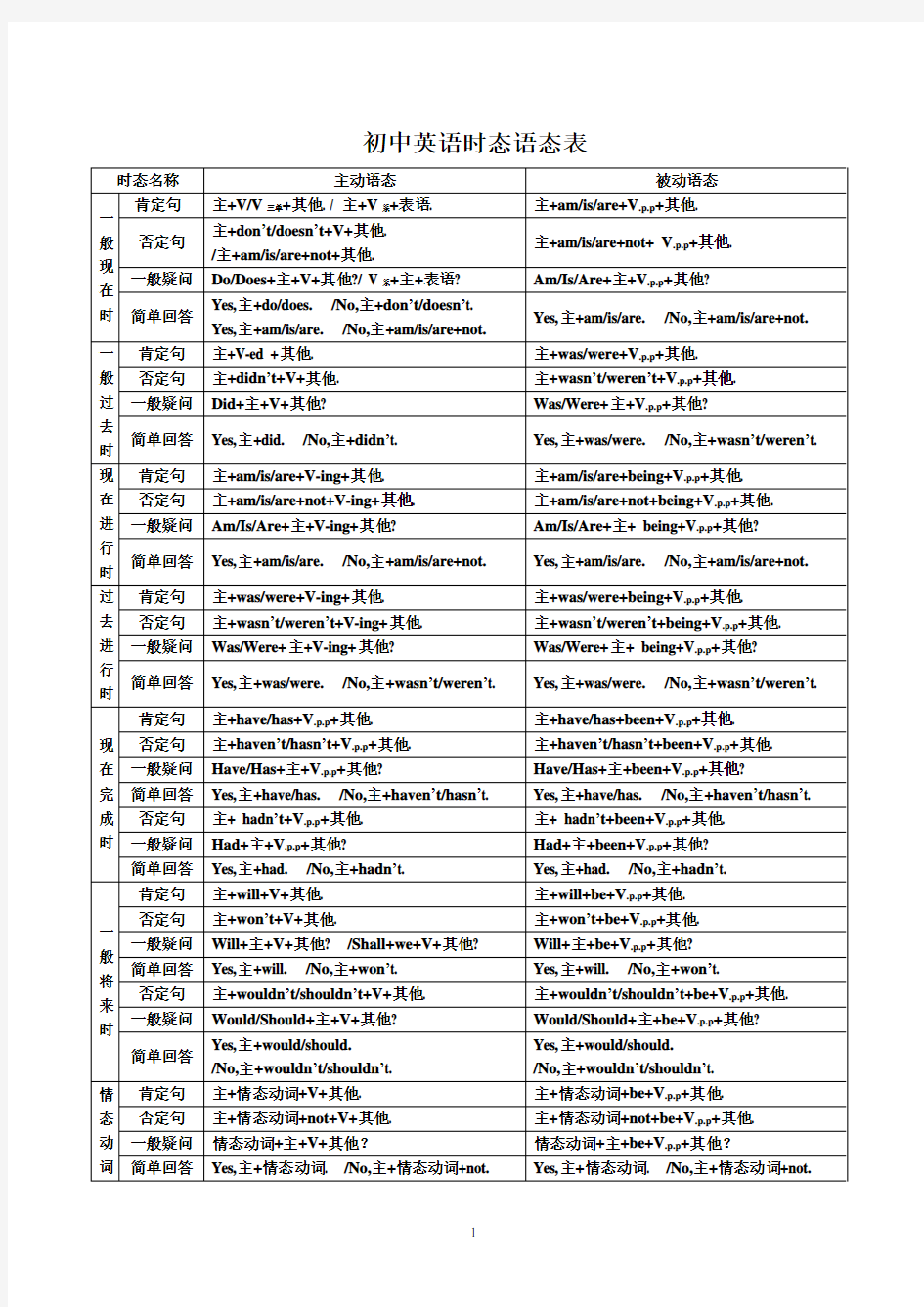初中英语语法与时态语态总结表

- 1、下载文档前请自行甄别文档内容的完整性,平台不提供额外的编辑、内容补充、找答案等附加服务。
- 2、"仅部分预览"的文档,不可在线预览部分如存在完整性等问题,可反馈申请退款(可完整预览的文档不适用该条件!)。
- 3、如文档侵犯您的权益,请联系客服反馈,我们会尽快为您处理(人工客服工作时间:9:00-18:30)。
初中英语时态语态表
动词的时态和语态
(一)动词是谓语动所表示的动作或情况发生时间的各种形式。一般现在时、一般过去时、一般将来时、现在进行时、过去进行时、现在完成时
1、一般现在时的用法
1)表示经常性、习惯性的动作;表示现在的状态、特征和真理。时间状语often, usually, every day,sometimes
a. He goes to school every day.
b. He is very happy.
c.The earth moves around the sun.
2) 在时间状语从句和条件状语从句中,用一般现在时表示将来。例如:
a. If you come this afternoon, we’ll have a meeting.
b. When I graduate, I’ll go to countryside.
3) 有时这个时态表示按计划、规定要发生的动作(句中都带有时间状语),但限于少数动词,如:begin, come, leave, go ,arrive, start , stop, return, open, close等。例如:a. The meeting begins at seven. b. The rain starts at nine in the morning.
4) 表示状态和感觉的动词(be, like, hate, think, remember, find, sound 等)常用一般现在进行时。a. I like English very much. b. The story sound very interesting.
5) 书报的标题、小说等情节介绍常用一般现在时。
2.一般过去时的用法时间状语last…,yesterday,this morning,
1)表示过去某时间发生的事、存在的状态或过反复发生的动作。
a. He saw Mr. Wang yesterday.
b. He worked in a factory in 1986.
2)表示过去经常发生的动作,也可用“used to “ 和“would + 动词原形”。
I used to smoke. During the vacation I wouldm in the sea.
注:”used to “表示过去常发生而现在不再发生的动作或存在的状态。“would + 动词原形”没有“现在不再……”含义。另外“to be used to+名词(动名词)”表示“习惯于…..”
a. I am used to the climate here.
b. He is used tomming in winter.
3.一般将来时的用法tomorrow,next…tonight(今晚)
一般将来时表示将来的动作或状态。其表达形式除了“ will 或shall + 动词原形”表示即将发生的或最近打算进行的事。
It is going to rain. We are going to have a meeting today.
2)“be to + 动词原形” 表示按计划进行或征求对方意见。
The boy is to go to school tomorrow. Are we to go on with this work?
3) “be about to+ 动词原形” 表示即将发生的动作,意为be ready to do sth. 后面一般不跟时间状语。We are about to leave.
4) go , come , start, move, sail, leave, arrive ,stay 等可用进行时态表示按计划即将发生的动作。I’m leaving for Beijing.
5) 某些动词(如come, go ,leave, arrive, start, get , stay 等)的一般现在时也可表示将来。
The meeting starts at five o’clock. He gets off at the next stop.
4.现在进行时的用法now,look,listen,at present
1)现在进行时表示现在正在进行的动作,由“to be + 现在分词” 构成。另外,“系动词+ 介词或副词” 也表示进行时的意义。What are you doing? The bridge is under construction.
2)表示感觉、愿望和状态的某些动词(如have, be , here, se, like 等)一般不用进行。
5.过去进行时的用法when,while
1)过去进行时过去某一时刻、某一阶段正进行的动作,由“ was (were) + 现在分词”构成。
In 1980 he was studying in a university. He was reading a novel when I came in.
6.现在完成时since,for,already,yet,ever,so far,
由“have + 过去分词其使用有两种情况:
1)现在完成时所表示的动作在说话之前已完成,但对现在有影响。句中没有具体时间状语。
He has gone to Fuzhou. He has been to Fuzhou.
2) 现在完成时所表示的动作开始于过去,持续到现在,也许还会持续下去常用for 和since表示一段时间的状语或so far , now, today, this wek (month, year ) 等表示包括现在内的状语。
He has studied English for 5 years. He has studied English since 1985.
Now I have finished the work..
注意:表示短暂时间动作的词(如come, go , die, marry, buy 等)的完成时不能与for, since 等表示一般时间的词连用。
3)现在完成进行时还可用时间和条件状语从句中,表示将来某时完成的动作。
I’ll go o your home when I have finished my homework.
If it has st opped snowing in the morning, we’ll go to the park.
(二)动词语态
1.当句子的主语是动作的执行者时,谓语的形式叫主动语态。句子的主语是动作承受者时,谓语的形式叫被动作语态。被动语态由助动词be + 过去分词构成,时态通过be 表现出来。
1)一般现在时:You are required to do this.
2)一般过去时:The story was told by her.
3)一般将来时:The problem will be discussed tomorrow.
